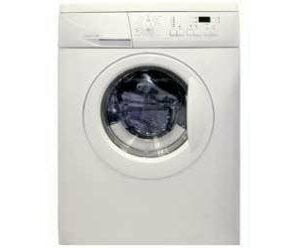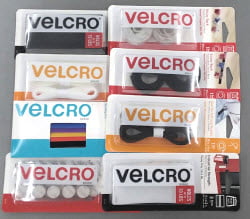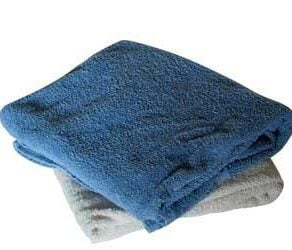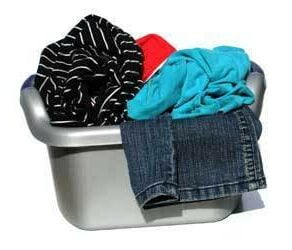Tina asked: I washed my chenille blanket with other clothes, and it shed all over everything! How do I get the shed off of everything?
Chenille,  along with towels, flannels and sweatshirts, are known as “lint givers.” This means they commonly release moderate to high levels of lint during the wash cycle. Removing this lint from other laundry can be a challenge, but in most cases, there is no permanent damage. Here are some steps to get the other laundry items back to normal.
along with towels, flannels and sweatshirts, are known as “lint givers.” This means they commonly release moderate to high levels of lint during the wash cycle. Removing this lint from other laundry can be a challenge, but in most cases, there is no permanent damage. Here are some steps to get the other laundry items back to normal.
Removing the Lint from Other Items
For the items that have become covered in lint that is not their own, use the steps below. If your lint is caused by paper, such as from a receipt in your pocket, use the guide How to Remove Washed Paper from Laundry.
You Will Need:
- Washing machine
- Dryer
- Dryer sheets
- Lint roller or tape, lint brush and/or fabric shaver
Steps to Remove the Lint:
- Start by taking each piece and giving it a good shake. This will shake loose some of the lint.
- The best way to remove the lint that has transferred to other items is by running them back through the washing machine and allowing the agitation of the water to do some of the work for you. Fill the machine with cold water and return the other pieces of laundry inside. Do NOT put the shedding garment back in with this load.
- Do NOT add laundry detergent.
- Run a normal cycle.
- Once finished, dry as normal, either line drying or machine drying. If the pieces can be machine dried, the dryer will remove additional lint.
- Dryer sheets can be added to reduce the amount of static that helps the lint stick to clothing.
- After the pieces are dry, remove them and give them another good shaking.
- Any remaining lint can be removed with a lint roller, brush or fabric shaver.
Removing the Lint from the Source Item
These are the steps to remove the lint from the items that is causing it.
You Will Need:
- Clothesline
- Tennis racket
- Lint roller or tape
- Lint brush
- Fabric shaver
Steps to Remove the Lint:
- Take the item outside and shake it to remove loose lint.
- Another option is to hang the item on a clothesline or over a porch railing and beat it like a rug using a tennis racket or rug beater to remove loose lint.
- Lay the item flat, preferably on a hard floor or outside so that the lint does not transfer to your carpet. A bed is another good place to lay the item.
- Use a lint roller, lint brush and/or fabric shaver to remove as much of the lint as possible. The shaver will work best for removing lint balls. The lint roller will work best for removing loose lint. The lint brush will work best for helping to loosen sticky lint that is not being easily removed by the lint roller. If you can use all three, the best process is to shave, roll, brush, then roll again. Repeat the process for the other side of the item. For clothing items, turn them inside-out to clean the insides as well.
- Once you have removed as much lint as possible, follow the steps below for Preventing Future Lint.
Removing the Lint from the Washer
- Wipe out the washing machine with a damp cloth. This will remove the bulk of the lint.
- Fill the washer with water but do not put in any clothes. Instead, use an aquarium net or pantyhose to skim the lint off the surface of the water.
- Put a couple lint-taker items in the wash, such as corduroy or polyester. The lint will stick to these items and can be removed after washing with a lint roller.
- There are washing machines that have lint filters to prevent the lint from building up in your plumbing. If your washer does not have a lint filter, you can put a leg of pantyhose over the drain, leaving the foot loose so that it can flow into the drain. Use the other leg of the pantyhose to tie the DIY lint filter in place.
Preventing Future Lint
- Wash the item by itself. The agitation of rubbing against other items in the washer can cause lint to form. If you have an HE washer, you can sometimes pour in extra water through the detergent dispenser.
- Use cold water, which will help prevent lint from forming.
- Wash the item in plenty of water. This will allow the blanket to move freely in the washer and prevent it from rubbing against itself, creating lint.
- Use the gentle or permanent press cycle to reduce the amount of agitation in the washer.
- If the item can be turned inside out, that may help prevent lint.
- Add either fabric softener or 1 cup of white vinegar to the final rinse cycle. This helps to prevent lint from forming.
- If possible, hang the item to dry. The heat and agitation in the dryer is a prime culprit for causing lint. If you do need to machine dry the item, use low or no heat.
- If you do use a dryer, using a dryer sheet can help if you don’t have fabric softener or white vinegar to put in the laundry. Do not use both a dryer sheet and fabric softener as the excess softener residue can cause lint.
- Take the item out of the dryer while it is a little damp to prevent exposing it to the static electricity formed when items are fully dried.
- Use laundry starch when ironing the item to lock lint in place.
Removing Tissue Lint from a Pocket
If you washed an item with a tissue in the pocket, the above methods can work (lint rolling, shaving, etc.), or you can try this method first to remove the bulk of the lint.
- Pull the pocket inside out.
- Fill a sink or bowl with enough water to submerge the pocket. A kitchen sink is best as they often have a drain catcher that will gather some of the removed paper when the sink is drained.
- Wet the pocket in the water, then pour a little (1/2 teaspoon) laundry detergent or castile soap onto the fabric of the pocket.
- Rub your fingers over the material to work the soap into the fabric and work the lint loose.
- Scrub the material with a soft scrub brush. An old toothbrush would work well. Dunk the fabric into the water occasionally to remove loosened lint.
- Rinse the fabric under the faucet with the water on high pressure.
- Repeat steps 3-6 until the bulk of the lint is off the fabric.
- Follow up with a lint brush or piece of tape once the fabric has dried.
Additional Tips:
- Wipe out the interior of your washing machine after washing your items. There will likely be a layer of lint. If it is not removed, it will be transferred to the next load of laundry.
- If you do not have a fabric shaver, a disposable razor can be used instead. To do so, lightly run the razor over the fabric. Use very light pressure so as not to cut or scar the fabric.
- There are lint remover balls you can buy that will gather excess lint during the wash.
- Be extra careful when washing “lint takers.” Items such as corduroy, permanent press clothes and velvet attract lint and should not be washed with items that tend to shed their lint.
- Wide tape also works well as a lint remover. Simply wrap it around your hand so that the sticky side is facing outward. Press it on the fabric and peel away. The lint will stick to the tape.
- If you need to remove lint on the go, a damp cloth or even just your hand with a little water on it can work.
Sources:
- Home Comforts: The Art & Science of Keeping House by Cheryl Mendelson
- Talking Dirty Laundry with The Queen of Clean by Linda Cobb
- The Spot and Stain Remover Handbook by Jean Cooper
- 10,001 Hints & Tips for the Home by Reader’s Digest
- Cleaning Plain and Simple by Donna Smallin
- The Cleaning Encyclopedia by Don Aslett








For lint – use masking tape, packing tape, or any sticky tape.
Most helpful. Many thanks!
Help, towels that I have been washing together for months, even years, are now getting lint on each other in the washing machine. I just moved apartments and no longer have a nice new front loader, but a refurbished traditional top loader. I’ve tried vinegar! I ran a hot wash with bleach! Nothing has helped. Is it the quality of the washing machine? I’m scared to wash anything nice in this machine!
Suzie,
Top loaders have an agitation bar in the center, making them more abrasive on laundry than a front loader. Use a gentle cycle to reduce the amount of agitation by the bar. Washing fewer towels per load can also help. Also, hot water is more likely to create lint than cold water.
I have lint balls stuck to my sheets and duvet cover. It hurts and irritates when we are sleeping with it covered on our body. Please help.
Cindy,
To remove the lint balls, use a fabric shaver. If you don’t have a fabric shaver, a disposable razor can be used instead. Just lightly run it over the surface of the fabric to shave off the lint balls. Once the balls have been removed, use the steps in the Preventing Future Lint section to stop them from forming again.
I’ve tried all your hints, but there is even an easier trick! I used the dish brush (for scrubbing pans), then laid the housecoat and pajamas out and voila! Done deal!! You could say I Macgyvered it!